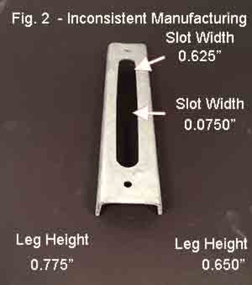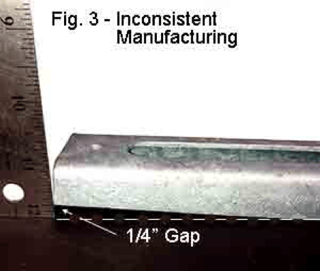Often, we get inquiries from customers asking us to quote on a quantity or series of items. Slide bearings, slotted steel shims, masonry anchors turnbuckle assemblies, etc. While we are always happy to do so, and appreciate the opportunity, it is sometimes difficult to get the customer to focus on the product as well as the cost.
 For this case, we will use the example of the masonry anchor called a slotted channel, also known in the industry as a channel slot, weld-on channel slot, Gripstay® Anchor or Gripstay® Channel Slot.
For this case, we will use the example of the masonry anchor called a slotted channel, also known in the industry as a channel slot, weld-on channel slot, Gripstay® Anchor or Gripstay® Channel Slot.
Slotted Channel
Looking at the #300 slotted channel (fig. 1) it is a relatively simple masonry anchor. When welded to a column or beam, it provides an anchor for many variations of masonry insert that will secure brick or block to the steel structure. Note, it also has two holes for shooting it onto the columns in the field. Although they almost never do, most of our steel fabricating customers actually have the equipment to make this item themselves.
A closer look at the slotted channel shows, like any manufactured product, that there are details that can be done well or poorly, resulting in a finished product that satisfies its intent 100%, or quite often, much less.
The slotted channel shown in fig. 1 is manufactured by The Steel Supply Company. It is produced from coil steel using a 240-ton progressive die stamping machine. This is important because the correct tooling and machinery allows for a very accurate, endlessly repeatable product. For example, the width of the slot in fig. 1 is a consistent 0.5625” (9/16”), as it is supposed to be. This allows the insert maximum strength while still allowing for free travel up and down the slot.

Fig. 2 is a competitive brand submitted to us by one of our structural steel fabricating customers.
Highlighting some of the differences;
- Obvious to the eye, the slot in the alternate brand slotted channel is not the same width from top to bottom. Starting at either end, it measures 0.670” wide. In the center, it is 0.750” wide. The tab of the Insert measures 0.45” wide. This leaves too much gap between the point where the insert makes contact with the slotted channel and the body of the insert. The result is the insert is substantially weakened.
- The slotted channel in fig. 2 and 3 is contorted so the legs are uneven. Looking at fig. 3, when one end (not shown) makes contact with the surface, the other end contorts as much as 1/4” off the surface.

- Lastly, the slotted channel in fig. 2 is hot dip galvanized. To function, this product has to be welded to an I-Beam, creating noxious gases that the welder will have to deal with. For this reason, The Steel Supply Company offers the slotted channel with a plain carbon steel finish, as well as mill galvanized and stainless steel. We do stock the hot dip galvanized slotted channel because occasionally, the shop drawings will call for it and the ability to make changes is not available, however fabricators will only use this when absolutely required.
To summarize the quality steps that are inherent in slotted channel made on the correct machines with proper and well-maintained tooling;
- All dimensions on the slot (the most critical part of the slotted channel) are uniform and correct. The slot is 0.5625” wide from top to bottom, and 5.450” long.
- The legs are of even height on both sides for the full length of the channel. This allows the channel to sit on the I-Beam without any gaps.
- Because it is stamped and folded on a continuous progressive die, pressure during the striking and bending is even and uniform. This produces a channel that is flat, end to end. There is no contortion.
Looking back at the original question of cost vs. product, it appears if the person being quoted had both items to look at while making a decision it may cast the prices quoted in a different light.





